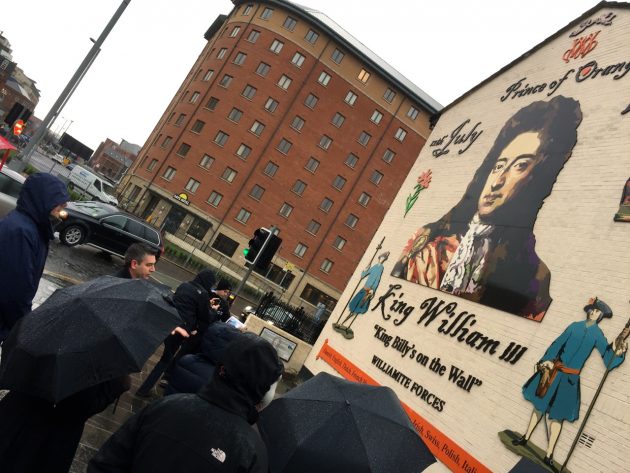As part of a work group, I went on a Sandy Row Tour, discovering the history and character of this neighbourhood.
We began at the well-known mural site at the entrance to Linfield Gardens — a large example of a re-imaging project. The UFF “Welcome to Sandy Row” has been replaced with a more permanent, metal affixed, “Let ambition fire thy mind” homage to King William.
Standing at Boyne Bridge, we learned that this was where the Belfast riots of 1864 were sparked, with the ashes of a burnt effigy tossed into the Blackstaff River.
We walked towards Weaver’s Court, with another example of a re-imaged mural. However, the new mural has been frayed by some years of sun, now curling back to review elements of the original paramilitary one.
The industrial park was once a formidable linen mill, employing hundreds. And was the birthplace of Linfield football club. Think about the name — linen field…
The original terraced houses are gone (though a row was transplanted, brick by brick, to the Ulster Folk & Transport Museum). Apparently it was a privilege to live so close to the linen works, even if there were up to 20 residing in a two-up, two-down dwelling.
We were told about the once thriving, owner-occupied businesses along Sandy Row itself. I shared my personal linkage; one of my wife’s great-grandfathers ran a cobblers shop here.
The former business at Ena’s Café was run by a husband-and-wife team — she managed births and he deaths — a regular matches and dispatches outfit.
Though at this point of our rain soaked expedition, we would have gladly welcomed a closer inspection and paid for a hot refreshment.
The obviously commissioned public memorials to those residents of Sandy Row that gave their lives to World War One, Two and ‘Ongoing Conflicts’ was augmented by the more ad hoc memorial garden to the UFF and John McMichael in particular. This was no sugar-coated trip nostalgic.
Though it would have been more inspiring to learn the local community’s plans for the future.
For example, the very next day the news of a newly approved urban village project for Sandy Row was announced. As we were physically on the ground, I would have appreciated a firsthand explanation of what that will mean for this neighbourhood.
This doesn’t detract from the professional and courteous tour provided by our local guides.
Our last two stops were at the appropriately named King William Park — a commemorative plaque to King William’s passing here en route to the Battle of the Boyne, with a more contemporary display of public art ten metres away — the Belfast Wheel — a large bronze circle showing the slices of the city, all fitting into one, each with a rich history and stories to tell.
External link to photo gallery (because Slugger WordPress Media slideshow feature broken): https://www.flickr.com/photos/mrulster/sets/72157650070075587/
Peacebuilding a shared Northern Irish society ✌️ Editor 🔍 Writer ✏️ Photographer 📸 https://mrulster.com
Discover more from Slugger O'Toole
Subscribe to get the latest posts to your email.

